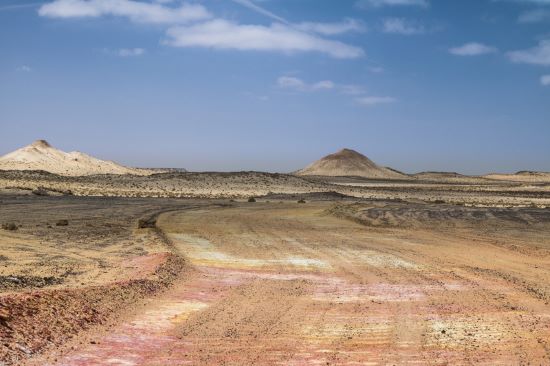A few days ago when I was talking to a young person about climate change I told the story about the Sahara Desert. Today, it is one of the driest and most barren places on Earth encompassing 9.2 million square kilometres (3.6 million square miles) and eleven countries. It is the world’s biggest and hottest desert. It wasn’t always the case.
How did such a large expanse of the African continent become such a barren place? Researchers studying climate tipping points have developed a statistical method looking at external influences that can eventually push an environment beyond a critical point. They applied their methodology to Sahara climate simulations and point to around 6,000 years ago when North African conditions were far different.
Andreas Morr and Niklas Boers, two researchers at the Technical University of Munich (TUM) and The Potsdam Institute for Climate Impact Research (PIK) created a methodology for advanced detection of potential tipping points in natural systems. Before the formation of the desert when North Africa was greener than it is today, Morr notes in a TUM news release, “Our findings suggest that the abrupt end of the African Humid Period was likely caused by a weakening of the system’s stability as the orbital configuration of the Earth changed, gradually pushing the system toward a tipping point.”
Boers describes how the advanced detection method they created allows for the monitoring and response to potential future tipping points affecting the natural world. He states, “Our results suggest that large-scale climate tipping events such as this can in principle be anticipated, hopefully enabling timely interventions.”
The published results of their work appeared in the June 4, 2024 edition of the journal of the American Physical Society, Physical Review X. The paper describes bifurcations and dimensional changes to stable equilibria in the natural world. As a read, it is a tough sledding. What it does point to, however, is that things can be going along smoothly in the natural world and then suddenly reach a critical point of climate forcing that leads to significant alterations. They construct a statistical model to describe a phenomenon they call critical slowing down or CSD which leads to “the vanishing of a stable equilibrium point.” In the paper, they apply their model to a physical candidate: the real-world transition that occurred in the Western Sahara 6,000 years ago.
The Western Sahara From Savannah to Desert
The Western Sahara before that “tipping point” was from the late Pleistocene to the mid-Holocene a savannah with lush vegetation. An external variable is seen as responsible for an abrupt climate change. In their paper, they write:
“Before 6 thousand years ago, the increased summer insolation in the Western Sahara facilitated the green Sahara via the following feedback mechanism: The vegetation in the region had a lower reflectivity than the desert and hence absorbed more solar energy, which can fuel convective systems and even cause a northward extension of the West African summer monsoon system.”
This humid period appeared to end abruptly which Boers describes as happening because “the orbital configuration of the Earth changed.”
Milankovitch Cycles and Other Causes for Climate Tipping Points
What Boers is referring to when talking about orbital changes are the Milankovitch Cycles which are long-term variations that occur in our planet’s orbit around the Sun combined with the axis tilt. These cycles come in three flavours:
- The 100,000-year orbit eccentricity cycle – Our planet’s orbit around the Sun is described as elliptical. We receive 23% more solar radiation when the planet is at the closest elliptical point to the Sun. Every 100,000 years, the elliptical nature of our orbit lessens to become more circular in a cycle that spans 100,000 years.
- The 41,000-year axis obliquity cycle – The Earth’s axis is tilted and oscillates between 22.1 and 24.5 degrees. Changes in the tilt are governed by the gravitational pull of the Sun, Moon, and other planets in the Solar System. The cycle has a periodicity of 41,000 years.
- The 20,000-year axis wobble cycle – Known as precession, the wobble cycle occurs because of the gravitational pull of the Sun and Moon affecting Earth’s equatorial bulges with a periodicity of 20,000 years.
There are other potential causes of the Sahara going from green to arid. These too could be factored into the critical climate-forcing model that Morr and Boers have developed. One is a 20,000-year periodicity that goes between a green and dry Sahara with the strengthening of the North African monsoon responsible for the former. In their paper, the authors refer to African Humid Periods of which the latest peaked around 10,500 years ago creating a savannah of lush grasslands and forests with lakes and rivers running through what today is an arid desert. Today, the evidence of these former lakes and rivers can be found in the subterranean world under the Sahara’s dunes.
There could be other factors to explain the desertification of North Africa. Some researchers point to anthropogenic causes with the natural world reacting with the growth of human pastoralism that led to goats and cattle causing negative vegetation feedback and an increase in dust in the atmosphere.
The CSD that Morr and Boers describe involves the vanishing of a stable equilibrium and a sudden tipping point and can be validated by the evidence of both the Milankovitch Cycles and anthropogenic activities.
Can the methodology help us to find and anticipate climate tipping points in the future? Boers believes so and suggests that their methodology could be used as an early warning system to address the consequences of human activity or other physical observations as we live through the changes to the climate and the Earth in the 21st century.









